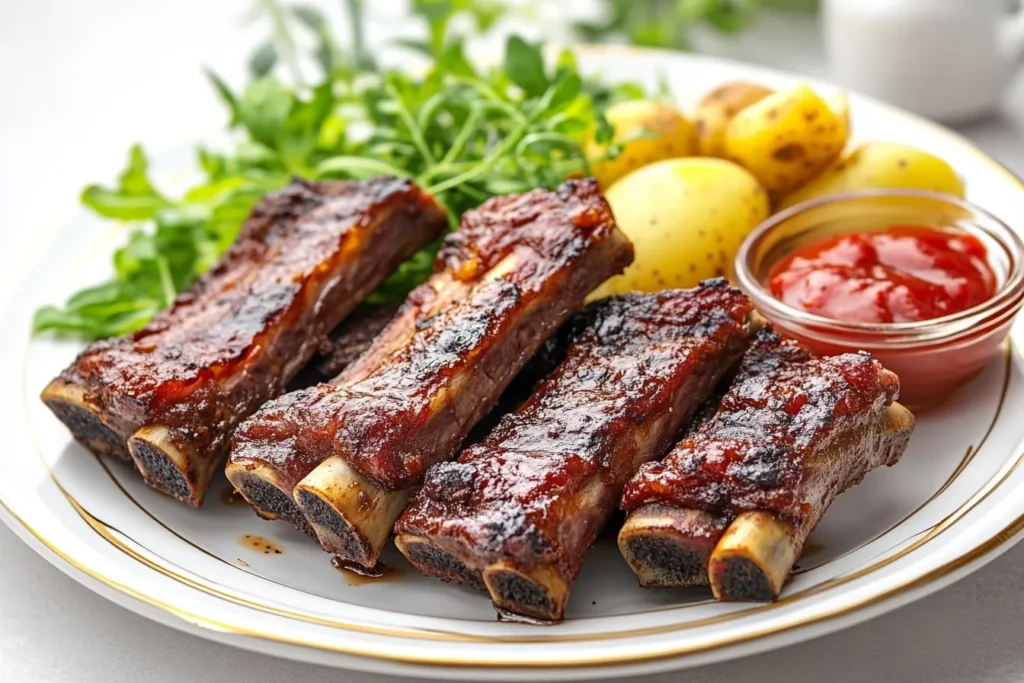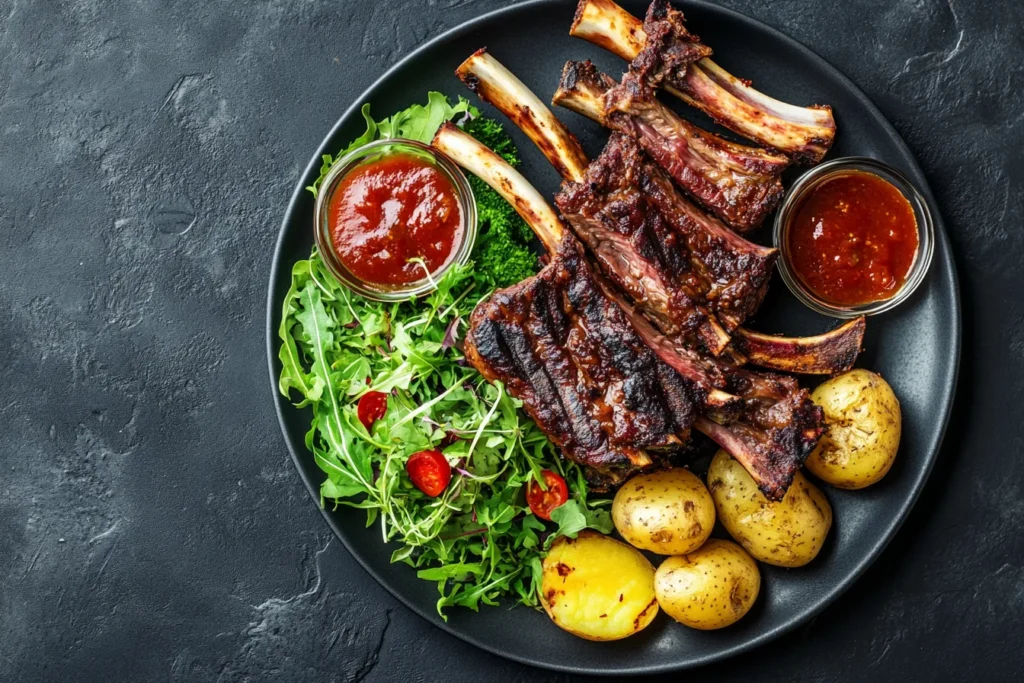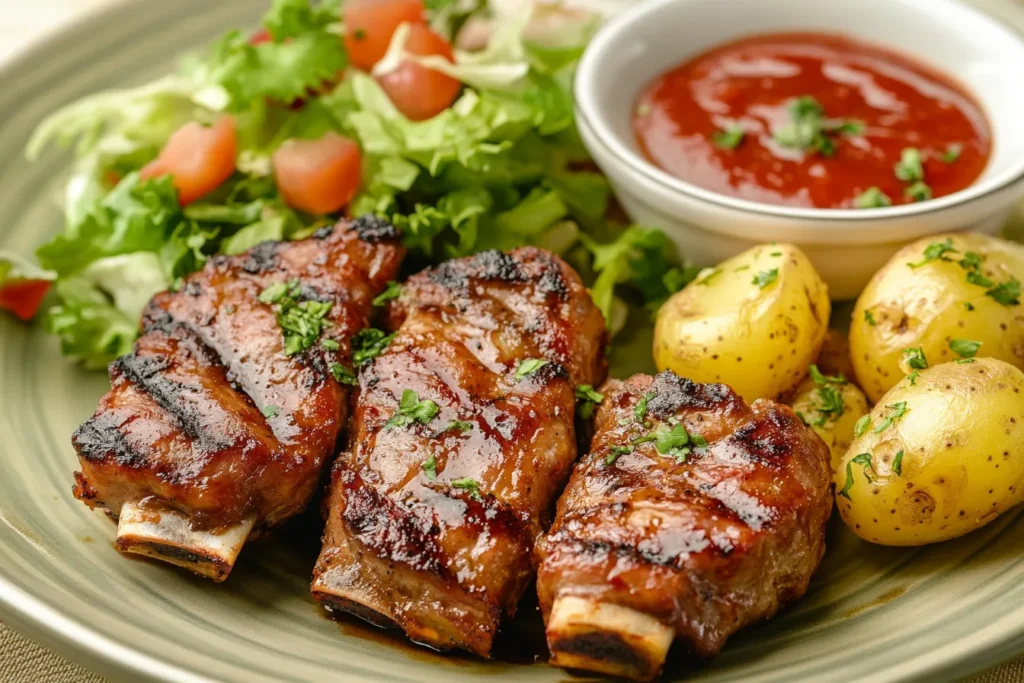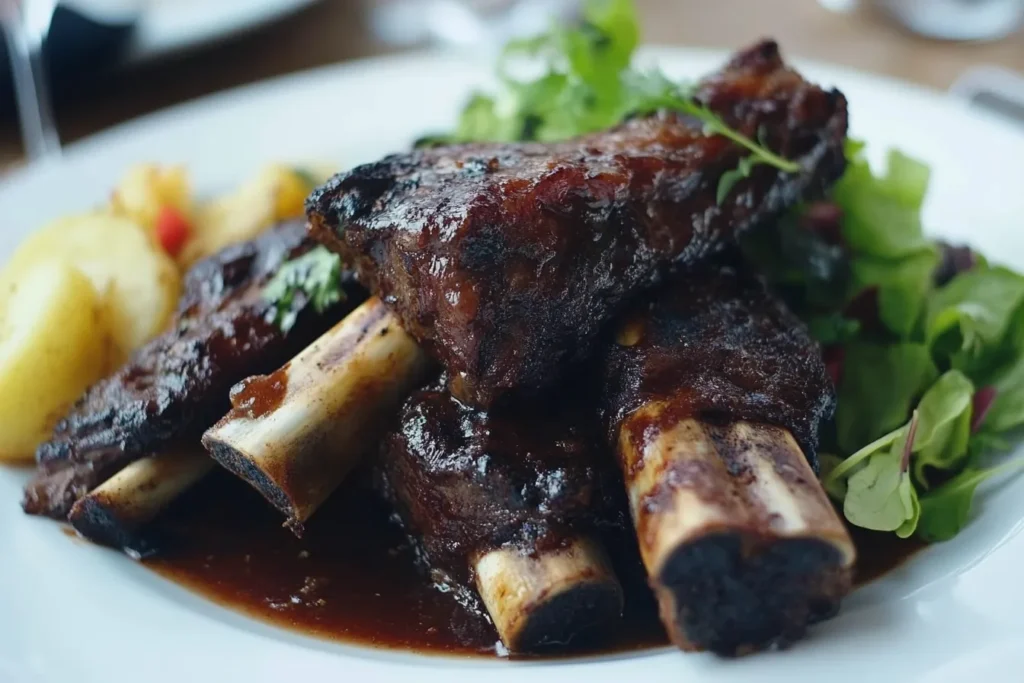Have you ever bitten into a perfectly tender rib at a restaurant and wondered how they manage to make it so fall-off-the-bone good? It’s not just about the recipe—it’s about technique, time, and a bit of culinary magic. If you’ve tried replicating those restaurant-quality ribs at home only to end up with something less than satisfying, you’re not alone. But here’s the good news: by understanding the secrets behind the process, you too can create ribs that are just as tender and flavorful as your favorite restaurant’s. Let’s dive into what makes these ribs so irresistible and how you can achieve the same results in your own kitchen!
List Of Contents
How Do Restaurants Make Ribs So Tender?
Cooking tender, flavorful ribs is both an art and a science. Restaurants achieve mouthwatering results through carefully honed techniques and years of culinary expertise. This comprehensive guide explores the secrets behind restaurant-style ribs, helping you replicate that fall-off-the-bone tenderness at home. Check out more recipes here.
Secrets Behind Restaurant-Style Tender Ribs

The Importance of Proper Cooking Techniques
The foundation of tender ribs lies in understanding how to cook them properly. Restaurants use specialized methods to break down connective tissues, creating a perfect texture. Check out more recipes here.
The Science of Tenderizing Meat
Collagen, the protein in ribs, breaks down when cooked slowly at low temperatures. This process transforms tough connective tissues into gelatin, which gives ribs their melt-in-your-mouth texture.
- Cooking at 225°F to 250°F allows for gradual collagen breakdown.
- Moisture retention is key; methods like spritzing or using water pans help ribs stay juicy.
Types of Ribs Used by Restaurants
Restaurants select specific cuts to match their desired outcome. The two main types of ribs are:
- Baby Back Ribs: Known for their tenderness and lean meat, these come from the upper part of the ribcage.
- Spare Ribs: Larger and meatier, these require more cooking time to achieve the same level of tenderness.
Choosing Quality Meat
The quality of ribs is pivotal to the final result. Experienced chefs prioritize the selection process to ensure tender meat. Check out more recipes here.
Why Marbling Matters
Marbling, or the distribution of fat within the meat, enhances both flavor and tenderness. Well-marbled ribs melt fat into the meat during cooking, keeping it moist and flavorful. Check out more recipes here.
Fresh vs. Frozen Ribs
Fresh ribs are often preferred for their superior texture. However, flash-frozen ribs can work well if thawed correctly. Avoid slow thawing, as it can lead to moisture loss.
The Role of Pre-Cooking Preparation
Preparation is critical in setting the stage for perfectly tender ribs. Restaurants take their time to prepare the meat before cooking.
Trimming and Cleaning Ribs
Removing the silver skin—a thin, tough membrane on the back of ribs—is essential. This step allows flavors to penetrate deeper and prevents chewy textures.
The Use of Dry Rubs and Marinades
Dry rubs and marinades are two popular techniques for infusing flavor and tenderizing ribs.
- Dry Rubs: Combine spices like paprika, brown sugar, and garlic powder to create a flavorful crust.
- Marinades: Incorporate acidic ingredients like vinegar or citrus to break down proteins gently.
Key Ingredients in Marinades for Tenderness
- Vinegar: Softens the meat while adding tangy notes.
- Soy Sauce: Enhances umami flavor.
- Pineapple Juice: Contains natural enzymes that break down connective tissues.
Low and Slow Cooking
“Low and slow” is the mantra for ribs. Cooking over extended periods at low temperatures ensures that collagen has time to transform into gelatin.
Why Low Temperatures Are Essential
Cooking ribs at high heat can lead to dry, tough meat. Low temperatures allow:
- Gradual softening of collagen.
- Even cooking, reducing the risk of burnt edges.
Recommended Cooking Times for Different Types of Ribs
- Baby Back Ribs: 4-5 hours at 225°F.
- Spare Ribs: 5-7 hours at the same temperature.
Smoking Ribs
Smoking is a hallmark of authentic barbecue. Using hardwood like hickory or applewood adds a rich, smoky flavor while cooking the ribs evenly.
Braising Ribs
Braising involves cooking ribs in a liquid, such as broth or beer, to lock in moisture. This method is especially useful for spare ribs, which require extra tenderizing.
Sous Vide Techniques for Maximum Tenderness
Sous vide cooking allows precise temperature control, ensuring ribs are evenly cooked and incredibly tender.
Wrapping and Foiling Techniques
Wrapping ribs during cooking helps retain moisture and speed up the tenderizing process.
What Is the Texas Crutch?
The Texas Crutch involves wrapping ribs in foil or butcher paper with added liquid, such as apple juice or butter. This technique creates a steamy environment that accelerates collagen breakdown.
Benefits of Wrapping Ribs During Cooking
- Prevents drying out.
- Locks in flavors from marinades or rubs.
- Speeds up cooking time without compromising tenderness.
Why Resting Meat Enhances Tenderness
Resting allows juices to redistribute throughout the meat, preventing dryness when slicing. Check out more recipes here.
How Restaurants Slice and Serve for Best Results
- Slice between the bones for even portions.
- Brush on a final layer of sauce or glaze for visual appeal and added flavor.
Maintaining Moisture During Cooking
Moisture is a critical factor in tender ribs. Restaurants use techniques to keep ribs juicy throughout the cooking process.
Spritzing and Basting Techniques
- Spritz ribs with apple cider vinegar or a mix of water and juice every 30 minutes to prevent drying.
- Baste with a flavorful sauce during the final stages of cooking.
The Role of Water Pans in Smokers
Placing a water pan in the smoker regulates humidity and temperature, ensuring even cooking.
Secret Ingredients Used in Restaurants
Restaurants often use hidden ingredients to create uniquely tender ribs.
Special Sauces and Glazes

Chefs craft signature sauces to enhance flavor and moisture. Popular bases include:
- Honey for sweetness.
- Mustard for tanginess.
- Molasses for depth.
Hidden Additives for Enhanced Tenderness
- Liquid Smoke: Adds a smoky flavor without using a smoker.
- Butter: Introduced during the wrapping phase for extra richness.
Using Technology for Precision Cooking
Modern tools allow restaurants to achieve consistent results.
Meat Thermometers and Probes
A meat thermometer ensures ribs are cooked to the ideal temperature of 190°F-205°F for tenderness.
Modern Restaurant Equipment for Perfect Ribs
- Commercial Smokers: Provide consistent heat and smoke.
- Sous Vide Machines: Allow precision cooking at controlled temperatures.
Achieving restaurant-quality ribs at home requires understanding the critical ingredients that enhance tenderness and flavor. These elements are often the secret behind the irresistibly tender ribs served at top barbecue spots.
Vinegar-Based Marinades
Vinegar is a staple in many rib marinades, offering both tenderizing power and a tangy flavor profile.
How Acids Break Down Meat Fibers
Acids like vinegar or citrus juice denature the proteins in meat, breaking them down to create a softer texture. This process:
- Makes the ribs easier to chew.
- Enhances the meat’s ability to absorb flavors from spices and sauces.
Balancing Flavor with Acidity
While acids are crucial, overusing them can make the meat mushy. A well-balanced marinade includes:
- Sweet elements like honey or brown sugar to offset the tang.
- Savory notes from soy sauce or Worcestershire sauce.
Enzyme-Based Tenderizers
Nature provides powerful tenderizers through fruits like papaya and pineapple. These fruits contain enzymes that break down proteins, making them perfect for rib preparation.
Papaya, Pineapple, and Other Natural Enzymes
- Papain (from papaya) and bromelain (from pineapple) are the key enzymes.
- They work by hydrolyzing proteins, making the meat tender and succulent.
How Enzymes Work on Meat Proteins
These enzymes break down collagen and elastin, the fibrous proteins responsible for toughness. To avoid over-tenderizing:
- Limit exposure time in marinades containing these enzymes to 1-2 hours.
- Combine with other tenderizers for balanced results.
The Role of Brines
Brining involves soaking meat in a solution of water, salt, and sugar. This method:
- Infuses the meat with moisture, preventing dryness during cooking.
- Allows ribs to absorb seasonings deeply.
Pro tip: Add aromatics like bay leaves or garlic to your brine for extra flavor.
Why Sugars Help with Caramelization and Tenderness
Sugar, when exposed to heat, caramelizes to create a delicious crust on ribs. It also:
- Balances the savory and smoky elements.
- Provides a protective layer that locks in moisture.
Spices and Flavor Profiles
Spices define the flavor of ribs and can also impact their texture when used thoughtfully.

Common Spices for Rib Rubs
Popular spice blends include:
- Paprika: Adds sweetness and color.
- Garlic Powder: Infuses a savory depth.
- Cayenne: Introduces a touch of heat.
How Spices Impact Texture
Salt in spice rubs acts as a natural tenderizer, breaking down muscle fibers. Meanwhile, sugar in rubs enhances caramelization, contributing to a delightful crust.
Smoke and Wood Selection
The choice of wood for smoking ribs significantly influences their tenderness and flavor.
Types of Wood for Smoking Ribs
- Hickory: A classic choice for its strong, smoky flavor.
- Applewood: Delivers a sweet, mild taste.
- Mesquite: Provides an intense, earthy aroma best suited for beef ribs.
How Smoke Infuses Flavor and Tenderness
Smoking ribs over low heat allows the meat to absorb the aromatic compounds in the wood. The extended cooking time also ensures collagen breakdown for tender ribs.
Timing Is Everything
Timing plays a critical role in rib preparation, from marinating to cooking.
Pre-Meal Preparation Timelines
Proper planning ensures optimal tenderness:
- Marinate ribs 12-24 hours in advance for maximum flavor absorption.
- Start cooking 4-6 hours before serving to allow adequate time for low-and-slow techniques.
How Overcooking Affects Tenderness
While undercooking leaves ribs tough, overcooking can result in mushy meat. Aim for:
- An internal temperature of 190°F-205°F.
- Checking for doneness by gently twisting a bone—if it moves easily, the ribs are ready.
Presentation and Final Touches
The way ribs are finished and presented elevates them to restaurant-quality standards.
Glazing Ribs for a Perfect Finish
A glossy glaze adds both flavor and visual appeal. Popular glaze components include:
- Honey or molasses for shine.
- Barbecue sauce for depth and tang.
Pro tip: Apply glaze during the last 10-15 minutes of cooking to prevent burning.
Garnishing and Plating
- Sprinkle fresh herbs like parsley for color contrast.
- Serve with complementary sides like coleslaw or cornbread for a complete meal experience.
Avoiding Common Mistakes
Even small missteps can compromise the texture and flavor of ribs. Awareness of common pitfalls helps avoid disappointment.
Overcooking or Undercooking
Cooking ribs at the wrong temperature or for too long can lead to undesirable results:
- Under-cooked ribs remain tough and chewy.
- Overcooked ribs lose their structure and become mushy.
Misusing Marinades or Rubs
- Avoid over-marinating with acidic ingredients, as this can break down the meat excessively.
- Apply dry rubs evenly to prevent overly salty or spicy bites.
Adapting Recipes for Home Cooking
Restaurant techniques can seem daunting, but they can be simplified for home kitchens.
Recreating Restaurant Techniques in Your Kitchen
- Use your oven or grill to simulate low-and-slow cooking.
- Experiment with smoking boxes or soaked wood chips for added flavor.
Simplifying Equipment and Tools
You don’t need professional equipment to make great ribs:
- Replace a smoker with a grill and a water pan.
- Consider using a slow cooker or an Instant Pot to make the cooking process easier and more convenient.
Healthier Alternatives
If you’re looking for healthier alternatives, there are methods to prepare ribs that are lighter but still maintain their tender texture.
Reducing Fat Content While Keeping Tenderness
- Choose leaner cuts like baby back ribs.
- Trim visible fat before cooking.
Using Leaner Cuts Without Losing Texture
- Increase marinating time to compensate for reduced fat.
- Use methods like braising or sous vide to retain moisture.
FAQs About Tender Ribs
Restaurant-quality ribs involve precision, care, and culinary expertise. In this concluding section, we address frequently asked questions and explore advanced methods to help you master the art of cooking ribs.
Why Do Ribs Need to Be Cooked Slowly
Cooking ribs slowly is fundamental to achieving tenderness.
Explaining Collagen Breakdown
- Ribs are rich in collagen, a connective tissue that transforms into gelatin when cooked slowly at low temperatures over an extended period.
- Quick cooking doesn’t allow enough time for this transformation, resulting in tough meat.
Low-and-slow cooking ensures:
- Juicy, flavorful meat.
- A texture that practically melts in your mouth.
Can You Over-Tenderize Ribs?
It is possible to over-tenderize ribs, leading to undesirable textures.

Signs Your Ribs Are Overcooked
- Meat becomes mushy and lacks structure.
- The ribs fall apart too easily when handled, losing the characteristic “bite.”
Avoiding Mushy Textures
- Monitor internal temperature closely, aiming for 190°F-205°F.
- Limit marination time, especially when using acidic or enzyme-based tenderizers.
What Makes Restaurant Ribs So Flavorful?
Flavorful ribs combine sweet, savory, and smoky elements, crafted through precise ingredient pairing.
Balancing Sweet, Savory, and Smoky Flavors
- Sweetness from sugar, honey, or molasses balances the savory spices.
- Smoky undertones, achieved through wood-smoking, provide depth.
Using Secret Spice Blends
Many restaurants develop proprietary spice blends that include:
- Paprika for warmth.
- Garlic powder for richness.
- Mustard powder for a tangy kick.
How Do Restaurants Serve Ribs Quickly?
Restaurants rely on pre-cooking and professional-grade equipment to maintain quality and speed up service.
Pre-Cooking Techniques
- Parboiling or steaming ribs before grilling shortens cooking time.
- Sous vide cooking allows for pre-prepared, perfectly tender ribs.
The Role of Holding Cabinets
Holding cabinets keep pre-cooked ribs warm and moist without drying them out, ensuring they’re ready to serve.
Do Ribs Need to Be Rested Like Steak?
Resting ribs is essential for maintaining moisture and enhancing flavor.
Why Resting Improves Texture
- Resting allows juices to redistribute throughout the meat.
- Cutting ribs immediately after cooking can lead to dryness as juices escape.
Best Practices for Resting Ribs
- Rest ribs for at least 10-15 minutes after cooking.
- Cover with foil to retain heat during the resting process.
Should You Remove the Membrane?
Removing the membrane is a common practice among professionals to improve texture and flavor absorption.
Pros and Cons of Removing the Membrane
Pros:
- Eliminates toughness.
- Allows spices and smoke to penetrate more effectively.
Cons:
- Removing the membrane requires extra preparation time.
How to Do It Effectively
- Use a knife to loosen the edge of the membrane.
- Grip with a paper towel and pull it off in one motion.
How Do Different Regions Prepare Ribs?
Regional styles influence the preparation and tenderness techniques used in rib cooking.
Differences Between Texas, Kansas City, and Memphis Styles
- Texas: Focuses on smoky, dry-rubbed ribs with minimal sauce.
- Kansas City: Known for sweet, sticky barbecue sauces.
- Memphis: Offers both dry and wet ribs, emphasizing spice blends and slow smoking.
Regional Variations in Tenderness Techniques
- Texas: Relies heavily on long smoking sessions.
- Memphis: Incorporates mopping techniques to retain moisture.
- Kansas City: Uses thick glazes to keep ribs tender.
Can You Make Tender Ribs Without a Smoker?
Yes! Smokers are ideal, but you can replicate their results with alternative methods.
Oven-Baked Techniques
- Cook ribs at 275°F in the oven for 3-4 hours.
- Add a water pan to maintain moisture.
Using Grills and Instant Pots
- Use a grill with indirect heat and wood chips for a smoky flavor.
- Instant Pots can pressure-cook ribs, followed by broiling for a crispy finish.
Tips for Beginners
Starting with ribs can be intimidating, but simple techniques ensure success.
Common Mistakes to Avoid
- Skipping the prep: Always trim and clean your ribs.
- Rushing the process: Avoid high heat; ribs require patience.
Essential Tools for Rib Cooking
- A digital meat thermometer for accurate temperature checks.
- A sturdy pair of tongs for flipping and handling ribs.
Sustainability in Rib Production
Choosing sustainable sources for ribs is becoming a priority for many cooks and restaurants.
Choosing Ethical and Sustainable Sources
- Look for ribs labeled as pasture-raised or organic.
- Purchase from local farmers or butchers who prioritize animal welfare.
How It Impacts Quality
Sustainably sourced ribs often have superior marbling and flavor, thanks to better feed and living conditions.
FAQs
1. How long should ribs be marinated?
12-24 hours is ideal for most marinades to ensure deep flavor absorption.
2. What’s the best wood for beginners to use when smoking ribs?
Applewood is a mild, forgiving choice that pairs well with pork ribs.
3. Can you cook ribs entirely in an Instant Pot?
Yes, but finish them on a grill or in an oven to achieve a proper crust.
4. How do you tell if ribs are done without a thermometer?
Bones should be slightly exposed, and meat should pull away with gentle pressure.
5. What’s the easiest glaze for ribs?
A mix of barbecue sauce and honey works well for beginners.
6. Why do some ribs taste chewy?
Chewy ribs are often undercooked, as collagen hasn’t fully broken down.
7. How do I avoid burning the glaze?
Apply it only during the final 10-15 minutes of cooking.
8. Can you make ribs in advance?
Yes, reheat them gently in an oven or grill to preserve moisture.
9. Do ribs taste better with dry rubs or sauces?
It depends on personal preference, though dry rubs allow for a crispier bark.
10. Are there vegetarian alternatives to ribs?
Yes, try smoked jackfruit or grilled tempeh as plant-based substitutes.
